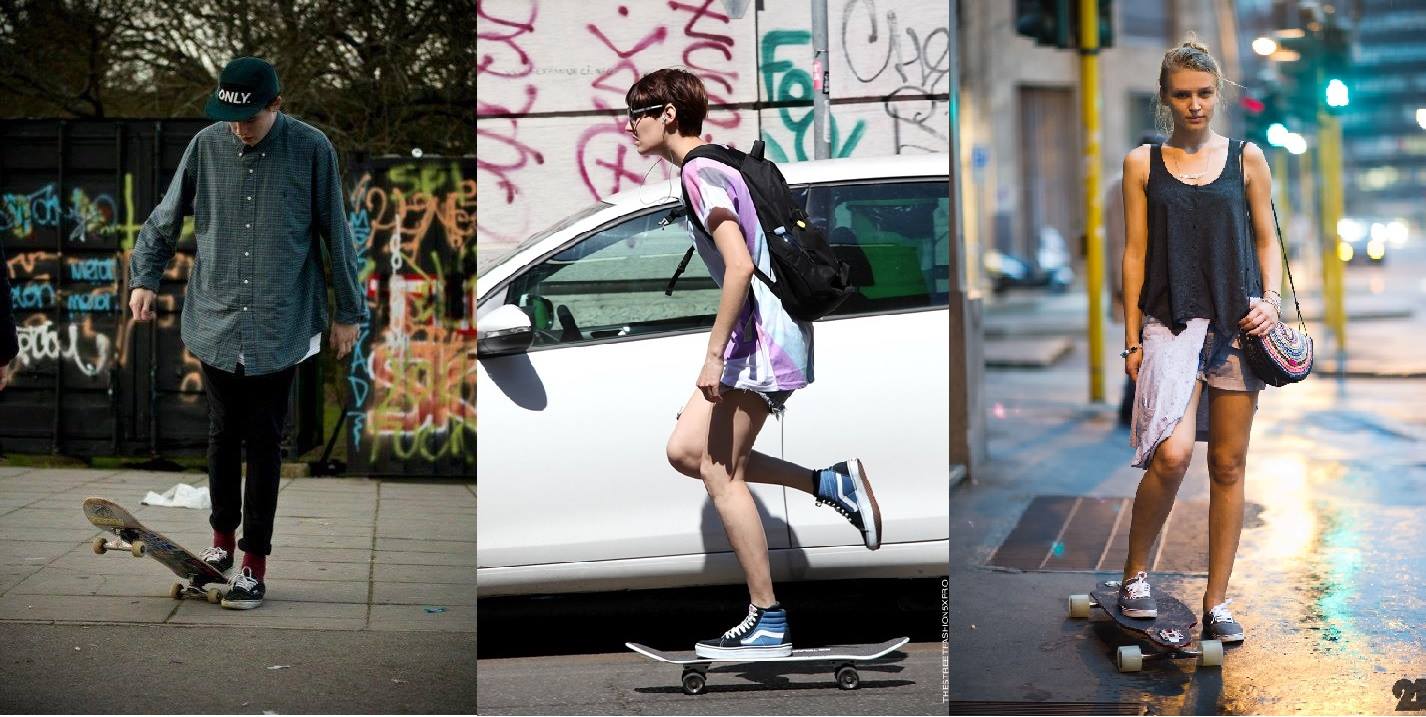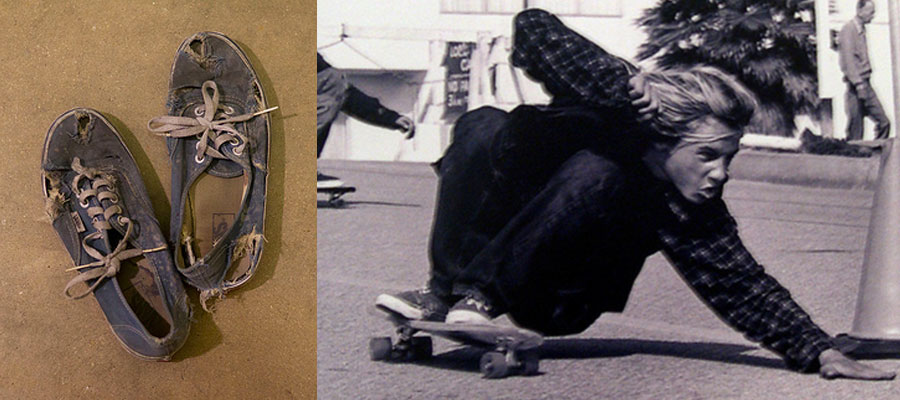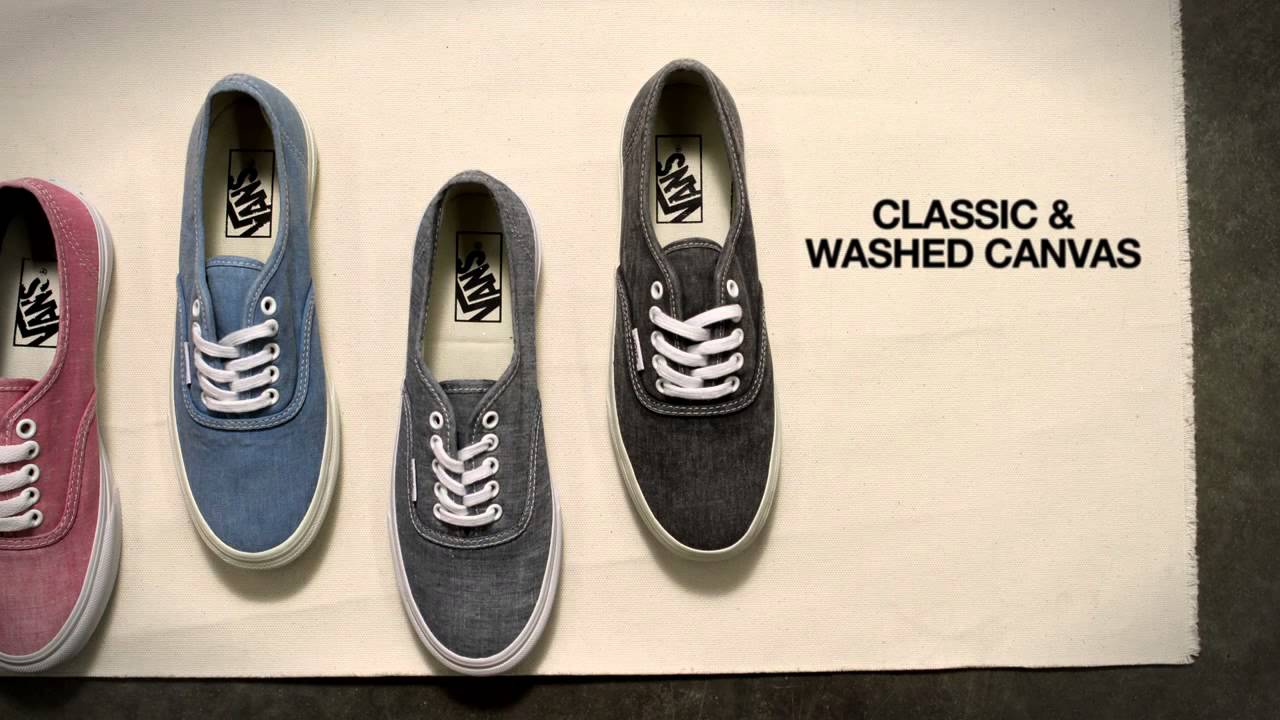- Details
- Written by: Lou Boyd

“How is it that a company like Vans, who makes a yearly income of over $2bn… manages to keep their cred?”The fact that skateboarding as a culture stands opposed to posers and money makers is more than understandable when you see that a lot of the athletes and events within the industry appear to run on little to no money. So how is it that a company that got their big exposure through Hollywood movie Fast Times at Ridgemont High, which makes a yearly income of over $2bn and which is frequently seen collaborating with the fashion world through designers like Marc Jacobs, Liberty and Kenzo manages to keep their cred, along with the approval of millions of skaters worldwide? To find the answer, you have to go back in time to the start.

 In the 1970s, Vans released the Sk8-Hi shoe. As skaters had become more and more the main audience for the Vans deck shoes, the Van Dorens decided to start specifically designing for them, not aesthetically, but practically. The Sk8-Hi, with its new padded high top, was made specifically to protect the ankles of skaters. Backed by big names like Tony Alva and Jerry Valdez, this is when Vans really won the support and became the choice footwear with skateboarders.
Accidentally stumbling onto an untouched market of consumers, this small company had won the respect of one of the most commercially difficult countercultures to sell to in America. Vans had done it by not trying to lead or follow the look of skateboarding, but instead by supporting the lifestyle and the skaters themselves with good manufacturing and simple shoes.
“[Vans] have always supported skateboarding and skateboarders,” Greg Hunt told Kingpin skate magazine in a recent interview.
“Nothing is really part of a bigger plan to have guys in contests; it’s really just about supporting skaters that embody and fit Vans. All these guys have a lot of respect for each other.”
“When you do get these guys together, there really is something special there, and it’s special for them to be on Vans – and it’s not just a big pay-check, it’s a heritage. All of them have been part of it a lot longer than I’ve been around. Now I don’t know if it’s reflected in the video, but if you get them together it really feels like a family.”
In the 1970s, Vans released the Sk8-Hi shoe. As skaters had become more and more the main audience for the Vans deck shoes, the Van Dorens decided to start specifically designing for them, not aesthetically, but practically. The Sk8-Hi, with its new padded high top, was made specifically to protect the ankles of skaters. Backed by big names like Tony Alva and Jerry Valdez, this is when Vans really won the support and became the choice footwear with skateboarders.
Accidentally stumbling onto an untouched market of consumers, this small company had won the respect of one of the most commercially difficult countercultures to sell to in America. Vans had done it by not trying to lead or follow the look of skateboarding, but instead by supporting the lifestyle and the skaters themselves with good manufacturing and simple shoes.
“[Vans] have always supported skateboarding and skateboarders,” Greg Hunt told Kingpin skate magazine in a recent interview.
“Nothing is really part of a bigger plan to have guys in contests; it’s really just about supporting skaters that embody and fit Vans. All these guys have a lot of respect for each other.”
“When you do get these guys together, there really is something special there, and it’s special for them to be on Vans – and it’s not just a big pay-check, it’s a heritage. All of them have been part of it a lot longer than I’ve been around. Now I don’t know if it’s reflected in the video, but if you get them together it really feels like a family.”
 While fashion draws from skate culture and profits from it, it seems like the Van Doren brand adds to the culture as much as it receives. From sponsoring skaters, to opening free skate parks, holding events and funding skate films, it seems as though without the brand, skate culture would find itself lacking in places.
“Every now and again high fashion looks to subculture for inspiration. It’s looking for an authenticity which they don’t really have,” says fashion editor Britta Burger.
“They come up with new colours, new fit, new styles every season and no one really needs that stuff. In order to be more real they look to attach themselves to scenes like skating.”
While fashion draws from skate culture and profits from it, it seems like the Van Doren brand adds to the culture as much as it receives. From sponsoring skaters, to opening free skate parks, holding events and funding skate films, it seems as though without the brand, skate culture would find itself lacking in places.
“Every now and again high fashion looks to subculture for inspiration. It’s looking for an authenticity which they don’t really have,” says fashion editor Britta Burger.
“They come up with new colours, new fit, new styles every season and no one really needs that stuff. In order to be more real they look to attach themselves to scenes like skating.”
“People are savvy and you can tell when people are wearing something because they’ve been paid to. You don’t only wear Vans if you’ve been given them, you go out and buy them.”
It’s an important point to make. In 50 years, Vans has not paid one celebrity to wear their shoes for an advertising campaign, choosing instead to show skaters or simply use models, street shots or simply shoot the shoes.
“Vans has authenticity,” says Burrger. “I think if skateboarders stopped wearing Vans then that would be the end of them.”
Of course, the company has not always been at the top of its game as it is now, it’s well documented that in 1984, the Van Dorens filed for bankruptcy after their range of basketball and other new types of shoes dug their profits into a deep hole. Reassessing their position, they came back with the answer that skaters had known all along. Vans doesn’t just offer shoes, it offers an authentic lifestyle and culture, shared between company and consumer. In moving away from their beginnings they had moved away from that happy relationship, they had to do something to find their way back . What they did was build a culture of events around themselves that has brought the company to a point when they’re arguably as well known for their Warped Tour, House Of Vans events and surf and skate contests as they are for their products, with events ranging from small hardcore punk events to big production hip hop concerts.“The brand reissued their classics, the Sk8-Hi 38, the Era 95 and the Slip-On 98”“Our relationships and collaborations are organic and represent a true partnership based on mutual admiration and shared creative values,” says April Vitkus, Vans Senior Director of Global Marketing. “House of Vans are able to showcase a unique cultural intersection that we have between punk and hardcore and rap and skateboarding, which have always been part of Vans‘ history and heritage.” It sounds like PR speak, yet it’s true. You’re as likely to see a pair of Vans on the feet of Take That as you are to see them on stage at a Leftover Crack gig or in a video with Tyler The Creator. It’s a strange phenomenon unreached by any other subculture brand.
 This year’s fiftieth anniversary shows that Vans now totally understands who they are, with celebrations that applauded their origins and the scene that got them where they are today.
The brand reissued their classics, the Sk8-Hi 38, the Era 95 and the Slip-On 98, shoes that have sold as well with new customers in their half decade year as they have with old school Vans lovers, a fact that proves the long lasting appeal better than any other.
The Vans/skater paradox shows that it doesn’t matter how big a company’s billboards get or how much money they have in their bank account, the fans will always stay as long as they keep one thing – Authenticity.
“As long as the core skaters keep wearing Vans, then Vans will always be around,” says Burger. “Skaters are more multifaceted artistically than any other boardsport. They usually play music, draw, take photographs or something alongside their skating.”
“Core skaters do their own thing, they wear what they want. Yes they have always gone against commercialisation and the big brands, and always should, they know when something is adding to the scene and when something is just randomly fitting something in to make money.”
This year’s fiftieth anniversary shows that Vans now totally understands who they are, with celebrations that applauded their origins and the scene that got them where they are today.
The brand reissued their classics, the Sk8-Hi 38, the Era 95 and the Slip-On 98, shoes that have sold as well with new customers in their half decade year as they have with old school Vans lovers, a fact that proves the long lasting appeal better than any other.
The Vans/skater paradox shows that it doesn’t matter how big a company’s billboards get or how much money they have in their bank account, the fans will always stay as long as they keep one thing – Authenticity.
“As long as the core skaters keep wearing Vans, then Vans will always be around,” says Burger. “Skaters are more multifaceted artistically than any other boardsport. They usually play music, draw, take photographs or something alongside their skating.”
“Core skaters do their own thing, they wear what they want. Yes they have always gone against commercialisation and the big brands, and always should, they know when something is adding to the scene and when something is just randomly fitting something in to make money.”
 So it seems that it doesn’t matter how many articles there are in GQ and Vogue about the mainstream appeal of Vans and it doesn’t matter how many big department stores start selling them, these are not the facts that matter to Skaters.
What matters is the Sk8-Hi design made for helping you skate, the Half Cab shoes, made because the company saw how people cut up skater Steve Caballero’s high top design for comfort, the classic checkerboard design, created as a response to Cali Kids drawing checks on their shoes nearly half a century ago.
What matters is how they fund and make films on skate and surf culture, they they’ve sponsored the Warped Tour since 1996 and created the Vans Triple Crown series, which includes televised BMX, motocross, surfing, skateboarding and snowboarding events. They see that Vans still sees them and what they’re about and get it.
In a culture of forced brand relationship and empty social media campaigns, Vans are the best example of real collaboration. If you commit to and support the scene you came from, then the scene will commit to you.
To read the rest of Mpora’s Style Issue head here
So it seems that it doesn’t matter how many articles there are in GQ and Vogue about the mainstream appeal of Vans and it doesn’t matter how many big department stores start selling them, these are not the facts that matter to Skaters.
What matters is the Sk8-Hi design made for helping you skate, the Half Cab shoes, made because the company saw how people cut up skater Steve Caballero’s high top design for comfort, the classic checkerboard design, created as a response to Cali Kids drawing checks on their shoes nearly half a century ago.
What matters is how they fund and make films on skate and surf culture, they they’ve sponsored the Warped Tour since 1996 and created the Vans Triple Crown series, which includes televised BMX, motocross, surfing, skateboarding and snowboarding events. They see that Vans still sees them and what they’re about and get it.
In a culture of forced brand relationship and empty social media campaigns, Vans are the best example of real collaboration. If you commit to and support the scene you came from, then the scene will commit to you.
To read the rest of Mpora’s Style Issue head here



